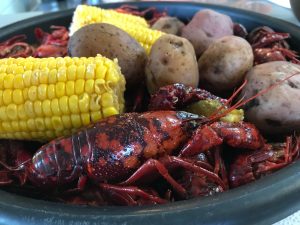
(Source: Wikimedia Commons, Joan DragonFly, CC-BY)
Food: A Better Source of Nutrients
When you hear the words “crawfish”, “jambalaya”, “shrimp étouffée”, and “po’boy”, what comes to mind? Louisiana, of course! Aside from southern hospitality, Louisiana is known for its food and continues to occupy a distinct role as one of the major ingredients in the worldwide food culture. From the shouts of the Who Dat Nation cheering on the New Orleans Saints to the sighs of contentment of the family enjoying their Sunday meal while overlooking the mighty Mississippi River, any day of the week is a day to indulge in the amazing flavors of Louisiana cuisine. There is an innate expectation that Louisiana’s food quality will equal or surpass the variety and portions of foods offered at any meal. Therefore, ensuring and maintaining food quality is essential.
One measurement of food quality is the amount of nutrients it contains relative to the amount of energy it provides. High-quality foods are nutrient-dense, meaning they contain significant amounts of one or more essential nutrients relative to the amount of calories they provide. Nutrient-dense foods are the opposite of “empty-calorie” foods such as carbonated sugary soft drinks, which provide many calories and very few other nutrients. Food quality is also associated with its taste, texture, appearance, microbial content, and consumers’ liking.
It is better to get all your micronutrients from the foods you eat as opposed to from supplements. Supplements contain only what is listed on the label, but foods contain many more macronutrients, micronutrients, and other chemicals, like antioxidants, that benefit health. While vitamins, multivitamins, and supplements are a $20 billion industry in the United States, and more than 50 percent of Americans purchase and use them daily, there is no consistent evidence that they are better than food in promoting health and preventing disease.
Everyday Connection
Make a list of some of your favorite foods and visit Food Data Central online (opens in a new window). You can also download the “What’s In the Food You Eat?” (opens in a new window) search tool as an offline Excel application. What are some of the nutrients found in your favorite foods?

Learning Activities
Technology Note: The second edition of the Human Nutrition Open Educational Resource (OER) textbook features interactive learning activities. These activities are available in the web-based textbook, not downloadable versions (EPUB, Digital PDF, Print_PDF, or Open Document).
Learning activities may be used across various mobile devices; however, for the best user experience, it is strongly recommended that users complete these activities using a desktop or laptop computer.
A substance in food that can provide energy, contribute to body structure, and/or regulate body processes.
The capacity of a body or physical system for doing work. There are two fundamental forms: kinetic energy and potential energy.
Food that is high in nutrients but relatively low in calories
Essential nutrients that are needed by the body in small amounts. These include vitamins and minerals.

